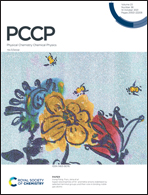Substitution pattern dependent behavior of the singlet excited states in symmetrically fluorinated biphenyls†
Abstract
Biphenyls are important basic chromophore systems that offer a possibility to study the effects of chemical substitution on the lower-lying excited states without complications from photoisomerization or other side processes. For several symmetric biphenyls, pristine biphenyl (bP0), 4,4′-difluorobiphenyl (bP2), 2,3,5,6,2′,3′,5′,6′-octafluorobiphenyl (bP8), and perfluorobiphenyl (bP10), we report stationary and ultrafast solution-phase spectra rationalized with the aid of computations by means of the XMCQDPT2 multi-configuration perturbation theory and TDDFT. Polyfluorination tends to broaden the gap between the nearly degenerate S1 + S2 pair of states and the S3 state in bP8 and bP10, yet relaxation from any sheet of the S1–S3 manifold leads through a system of state crossings to the same stationary points in S1. Unlike bP0 and bP2 where the relaxed excited state is planar and non-polar, excited bP8 and bP10 exhibit sudden polarization to give a symmetry-lowered excited state via pseudo–Jahn–Teller interactions involving S1 and S2. Of particular interest is excited bP10 which reveals both sudden polarization and loss of planarity of one phenyl ring. We also demonstrate the unsatisfactory performance of the TDDFT methodology as applied to the biphenyls.



 Please wait while we load your content...
Please wait while we load your content...